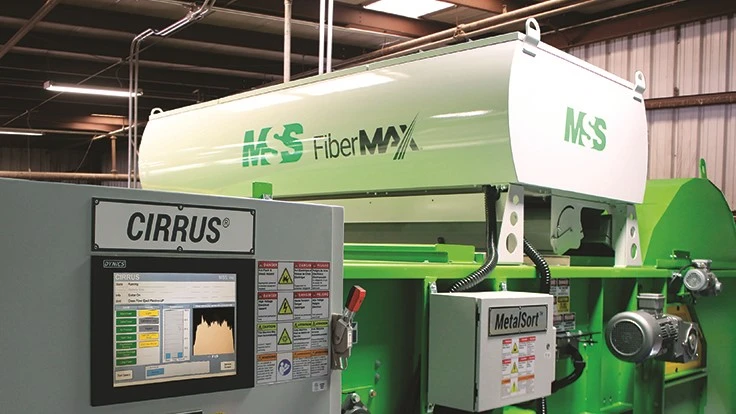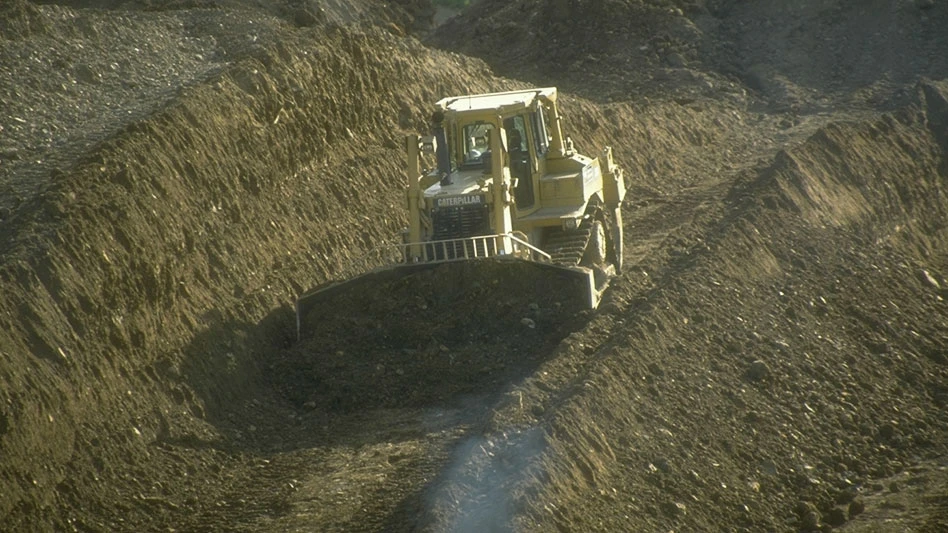
When the Austin, Texas-based Balcones Resources set out to upgrade its facility in early 2017, the main focus was on automation. Managers at the material recovery facility (MRF) had a difficult time staffing a second shift that ran five days a week—an issue that robotics and optical sorters showed promise to alleviate. With the rising level of labor costs, the company felt the automation had the potential to decrease operating costs as well.
Then, National Sword hit the U.S.
China’s list of restrictions and contaminant thresholds, first announced in 2017, quickly caused a rippling effect in MRFs, where material that was once shipped overseas began to be stockpiled. Mixed paper, along with specific plastic grades, continues to take a hit from the regulations today. According to Fastmarkets RISI’s PPI Pulp & Paper Week issued March 22, average prices were -$3 per ton for mixed paper, making quality a growing emphasis for recyclers.
While Balcones’ initial priorities remain, the nearly $5 million of upgrades being installed in April have taken on a new focus: moving more material while reducing as much contamination as possible to maximize quality.
“The intent of our upgrade this year is designed to … continue to maintain our high level of quality and control and create efficiencies internally on an operational scale that will enable us to continue providing service to our customers at continuously competitive rates,” says Joaquin Mariel, the vice president of recycling at Balcones. “The upgrades on our equipment will affect all of our lines, but it’ll definitely have the highest impact on helping us create cleaner paper.”
Optical upgrade
Bulk Handling Systems of Eugene, Oregon, designed Balcones’ current system, which handles about 16,000 tons of commercial and residential material per month. Single-stream material flows from a metering bin into the system, where it’s first manually presorted to remove any large contaminants or items that may cause damage.
Then, the material moves across a series of disc screens that sort by size and shape. The first is a cardboard screen that removes large, flat pieces of material while the rest of the stream falls through the screen. Directly underneath, another screen breaks and removes glass before the rest of the material passes.
The remaining material then moves to two screens that sort paper from containers. After that series of screens, the material moves across a container line, where cross-belt magnets pull ferrous steel out of the mix. The rest moves across an eddy current separator to remove aluminum, followed by two optical sorters that remove polyethylene terephthalate (PET) and mixed plastics No. 3 through 7. Manual sorters also work to pull high-density polyethylene (HDPE) plastics by hand, as those are the plastics of highest value.
Balcones is working with CP Group of San Diego to install its upgrades, which include new fiber screens, an upgrade to the glass-cleaning portion of the system and a Reb-4 two-ram baler from Sierra International Machinery, headquartered in Bakersfield, California.

But the heart of the upgrade will be Cirrus FiberMax optical sorters from Nashville, Tennessee-based MSS Optical Sorters Inc., the optical sorter division of the CP Group.
The system features three optical sorters designed to separate fibers using near-infrared (NIR) technology to target and sort through the mixed paper stream moving through the system.
The first optical sorter removes contamination from the paper line, including plastic containers, film, metal and trash. The second sorter is capable of separating white office paper from the rest of the mix, which Felix Hottenstein, the sales director of MSS Optical Sorters, says is particularly useful for loads with high volumes of white paper and some contamination. Finally, the third optical sorter is meant to positively identify paper and sort it, leaving the rest of the material destined for landfill on the belt.
Positive sorting involves nozzles blasting air onto the line to remove the paper from the trash. The first two sorters work in the opposite way, removing unwanted or specific material from the commodities on the line, Hottenstein says, which tends to be less effective in controlling quality.
“If you remove contamination, the quality is still not good enough,” Hottenstein says. “If we do a positive sort on the paper, the quality is quite a bit higher.”
Hottenstein says the system can run up to 1,000 feet per minute and make about 2,000 picks in that time, whereas eight hand sorters would be able to make a total of about 400 picks per minute.
Paper problems
MRFs around the country are scrambling to add automation to their systems to create efficiencies and reduce contamination in the wake of the National Sword. For example, Recology recently completed a $14 million upgrade to its 200,000-square-foot MRF in San Francisco, which is now home to seven optical sorters. The company says the upgrade improved recycling by 9 percent in 18 months.
While other types of optical sorters exist to target specific commodities—anything from plastic bottles to electronic scrap—Hottenstein says the FiberMax has been the company’s most popular line of equipment. The model has been a common choice for commercial paper recycling operations, but Hottenstein says it’s become increasingly popular in MRFs accepting residential streams, too.
China’s policies have affected other commodities, but paper products remain the focus of many MRF operators. Paper commodities still represent the largest volume of incoming material at single-stream MRFs, Hottenstein says. They’re also the hardest to store. While materials like plastics and aluminum can be stored outside, paper goods are more easily damaged by the elements.
“We’ve installed dozens of these over the past 12-18 months,” Hottenstein says. “The requirement to add solutions to clean up paper was the most pressing one for all these MRFs.”
Though optical sorters have been a popular response to the ongoing changes in the recycling industry, Hottenstein warns that the upgrades come at a price.
“Optical sorting is one of those technologies that can help, but it’s not a cheap way to do it. Quite a bit of capital has to be invested,” Hottenstein says. “Those companies, whether private haulers or municipalities, have to have a certain contract length still on the books in order to make these upgrades work.”
Quality versus volume
Balcones’ upgrades will give the company the ability to separate white paper from mixed, making it one of few facilities in the country to have the capability, Hottenstein says. That doesn’t mean white paper separation will become a staple of the facility, though.
“When you run residential, the first unit is going to be pretty busy, while the second one is not,” Hottenstein says. “Commercial is the opposite.”
Mariel says Balcones’ Austin MRF, which runs single-stream commercial and residential material in separate shifts, doesn’t currently have enough white paper coming in to put the second sorter to regular use. It’s a choice operators need to make when installing similar equipment—whether the volume of material justifies the cost of operations to process it.
For now, Mariel says, Balcones is focused improving the quality of its mixed paper material and old corrugated containers (OCC).
“The lower-hanging fruit in operations like ours is being able to process more volumes of this material at a lower cost to us, and therefore, to our customers, and then to be able to continuously create clean products that we’re marketing to the mills and downstream processors that are purchasing from us,” Mariel says. “That’s really our highest priority— to maintain those relationships and that quality at the highest levels so that we can continue to do business.”
The author is the assistant editor for Waste Today magazine and can be contacted at tcottom@gie.net.
MRF Operations Forum releases 2019 agenda
The agenda has been released for the MRF Operations Forum 2019, which is scheduled for Oct. 22 at the Marriott Chicago Downtown Magnificent Mile in Chicago. The event is designed specifically for material recovery facility (MRF) operators seeking to optimize their plants. In addition to that topic, this year’s agenda focuses on plant automation and robotics, case studies on recent MRF retrofits and a workshop focused on solving problems faced by all MRF operators.
The event is designed for plant managers, maintenance managers, regional managers, owners, consultants, engineers, government officials, equipment suppliers and anyone else interested in better understanding plant operations and technology.
Attendees have the opportunity to attend a Meet and Greet from 5:30 to 7 p.m. Monday, Oct. 21, before programming kicks off the following morning.
The event is hosted by the Recycling Today Media Group, Valley View, Ohio, in partnership with RRT Design & Construction, Melville, New York.
After opening comments from Jim Keefe, publisher of Recycling Today Media Group, and Nat Egosi, president of RRT, attendees have the opportunity to hear about Robots in Action from suppliers’ and operators’ perspectives in two back-to-back sessions that begin at 8:45 and 10:15 a.m., respectively.
From 11:15 a.m. to 12:30 p.m., panelists share their perspectives on plant optimization, specifically looking at how they have increased their plants’ throughput and improved quality and uptime without additional capital investments.
From 1:30 to 3 p.m. is a new workshop titled Solving Shared Problems. In this interactive session, attendees are divided among tables and assigned one of several pressing topics facing the industry to discuss. A facilitator for each group then summarizes the discussion and shares strategies that have worked for the participants in his or her group.
Career Advice: Managing vs. Leading begins at 3:30 p.m. Hear advice from an industry leader on motivating and influencing employees to perform at their best.
From 4 to 6 p.m., representatives from a number of MRFs share their experiences and the lessons they have learned from recent retrofits of their plants. Attendees learn how these changes have affected their overall operations.
The event concludes with a Networking Reception from 6 to 7 p.m.
The MRF Operations Program precedes the 2019 Paper & Plastics Recycling Conference, which is scheduled for Oct. 23-25 at the same venue. Discounts are available for those attending both events. Additional details and registration information can be found at http://opsforum.recyclingtodayevents.comand at http://paperplasticsna.recyclingtodayevents.com.
Latest from Waste Today
- Anaergia Services enters into contract with Rialto Bioenergy Solutions
- Casella announces offering of revenue bonds
- New Hampshire pauses proposed landfill rules
- Waste Connections, Food Science Corp. partner with Texas city to recycle food waste
- Waga Energy signs partnership agreement with technology provider
- AMCS launches the AMCS Platform Winter 2024
- Pettibone adds new model to telehandler line
- Waste Pro near top of Florida private companies list





